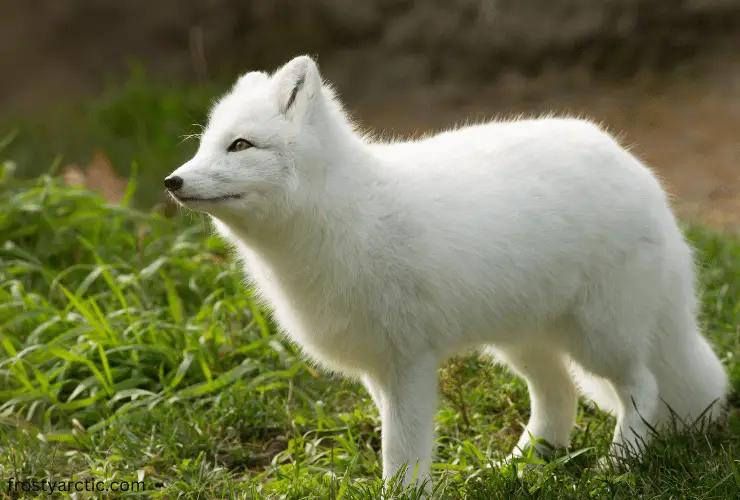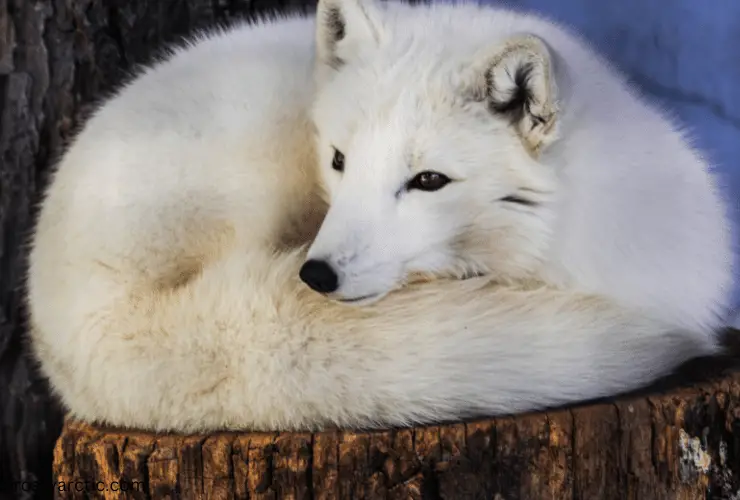Arctic foxes are those that we find in the region that belongs to the Arctic, the area named Alaska. They prefer the area with no trees due to its cold temperature being covered with ice. According to the Alaska Department of Fish and Game, these foxes live in a Tundra habitat. ~(Source)
The overall area is from Aleutian Island to Point Barrow and from the east to the Canadian border.
About Arctic Fox (National Geographic Kids)
Arctic Fox (Vulpes Lagopus), also known as snow fox, polar fox, or white fox. They are native to Arctic areas and common in the regions of the Arctic tundra biome.
According to genetic studies, 8 different subspecies of the Arctic fox are found in the animal world ~(Source).
- Ungava Bay Arctic fox Vulpes lagopus ungava
- Pribilof Islands Arctic fox Vulpes lagopus pribilofensis
- Bering Island/Sea Arctic fox Vulpes lagopus beringensis
- Hall Island Arctic fox Vulpes lagopus hallensis
- Spitsbergen Arctic fox Vulpes lagopus spitzbergenensis
- Greenland Arctic fox Vulpes lagopus groenlandicus
- Iceland Arctic fox Vulpes lagopus fuliginosus
- Mainland Arctic fox Vulpes lagopus lagopus
Do Arctic Foxes Live in Antarctica or the Arctic?
The straightforward answer is No. Arctic Foxes do not Live in Antarctica; instead, they are known as an animal of the Arctic region.
According to The Swedish Arctic fox project (2004) by Magnus Tannerfeldt (The Swedish Research Council Formas), Anders Angerbjörn and Pall Hersteinsson – Nowadays, Arctic foxes live in Alpine and Arctic Regions of Tundra.
Besides, Arctic Foxes are available on the coasts of Iceland, the Commander Islands, the Bering Sea, islands of the Aleut archipelago and the subarctic seas.

The number one reason for the existence of Arctic Foxes in Arctic areas is the abundance of plant growth and food supply.
On the other hand, Arctic Foxes are extinct in Antarctica because it’s not a place for plant growth due to extreme cold and ice formulation.
ADFG reckons the arctic foxes are seen in the areas of Alaska only. They live between the Aleutian Islands north of Point Barrow and East of the Canadian border.
They use the dumps in Northern Alaska when they are active. And while inactive, they use the underground dens and tunnels to rest. They also prefer sandy soils during rest.
Note: Arctic regions are heaven to Arctic foxes because they find the following food cycle there.
- Lemmings
- Voles
- Rodents
- Insects
- Berries
(None of the above-mentioned food is found in Antarctica)
Where Do Arctic Foxes Live in Canada?
Although Alaska belongs to the US region, the Arctic foxes live in Canadian territories. Firstly, the Yukon province has several regions home to Arctic foxes, and the northern Boreal region is the prime.
Based on Nature Conservancy Canada’s journal, from that area to Newfoundland and from Ellesmere Island to James Bay, arctic foxes are seen massively.
Eventually, it can be stated that Alaska is not only the home of Arctic foxes.
Where Do Arctic Foxes Live in The Tundra? How Many Arctic Foxes Live in The Tundra?
Tundra (covered with snow for much of the year) is a habitat where no trees exist. And several places around the globe are noted as Tundra habitats. Such as-
- Alaska
- Northern Regions of Canada
- Russia
- Greenland
- Norway
- Finland
- Sweden
- Iceland, etc.
Among these regions, Arctic foxes are prevalent everywhere. But in the territories of the US and Canada, these foxes are mostly seen.
It is hard to determine the total population of Arctic foxes, yet a rough estimation is 110,000. Shockingly, the number changes in three to five years.

Note: The number of Arctic foxes also reduced in Alaska because two humans were attacked by a rabid Arctic fox (Alopex lagopus) in 1994. ~(Ballard et al., 2001).
What Climate do Arctic Foxes live in?
Their appearance talks a lot about their preferred place and climate to live in.
Their furry soles and body allow them to survive in an environment where temperatures go as low as -50°F.
Moreover, they are carnivores, requiring no vegan food in their life cycle. Again, their short ears and muzzle allow them to easily find food in icy areas.
According to research, Arctic foxes are immensely known for their magnificent appearance to survive in the cold climate. They can tolerate up to 0 to -58°F temperature with no effort.
As a result, they choose the world’s two coldest places as their natural home. The first is the arctic tundra, and the other is sea ice. Moreover, the foods they rely on are available in these areas.
However, there are some other facts about their survival. Those are,
a) Arctic Foxes Live in The Summer
When the summer arrives, Arctic foxes start living in the tundra at the forest’s edge, says NHPBS. Since they rely on the available foods in that area, they shift themselves.
b) Arctic Foxes Live in The Winter
They do the opposite in the winter than in the summer. They started being in the ice-covered area.
Their white fur provides a significant privilege to camouflage themselves. And they determine the dens and tunnels as their home in the winter.
Why do Arctic Foxes live in Cold Places?
Arctic foxes survive in cold places due to many factors. Here are the major factors that allow them to live flawlessly in cold places.
- First comes their body shape, which is round and compact. According to Defenders of Wildlife, the round and compact body shape help them reduce the barrier against the cold air.
- After that, their muzzle, ears, and legs are concise. The size helps them to produce massive heat in their body to survive cold temperatures.
- The fur, which is enormously dense and deep, helps them retain the produced heat in their body.
- About their paws, they have furry soles which let the skin out of contact with ice.
Due to these natural reasons, they are highly adaptive to cold places.
How Do Arctic Foxes Live in The Cold?
As we mentioned earlier in this composition, their bodies allow them to survive the deadly temperature without any effort.
During the winter period, the arctic foxes become active and roam around. They select the dens and tunnels as their home beside riverbanks or coastal areas.
How Do Arctic Foxes Stay Warm in Winter?
Arctic foxes are amazing survivors like the polar bears. They can generate excessive heat in their body. Moreover, their dense fur can retain the generated heat in their body.
Again, the fur is the reason that they remain intact from the cold air and circumstances. Due to their round body shape, they can surf in the cold air without absorbing the temperature.
Long tails, concise ears, muzzles, and legs also help them generate heat in their bodies.
Note: About their body, ‘they have all the optimal preparation to stand in this freezing climate such as furry soles, concise ears, and muzzle,’ says National Geographic.
FAQs
Do arctic foxes live in the north or south pole?
Answer: Arctic foxes live at the north pole. Since Arctic foxes’ food is not available at the south pole, they prefer the north pole.
What temperature do arctic foxes live in?
Answer: Arctic foxes are known for their incredible caliber to survive in cold places where the temperature is below 0°F. In addition, this creature can tolerate long winters below 0°C for 6 -10 months/yearly.
Do Arctic foxes live with polar bears?
Answer: Straightforwardly, the arctic foxes live with the polar bear. Like the bear, it becomes nomadic in the winter and starts living in the coastal areas.
How rare is an arctic fox?
Answer: The number of arctic foxes changes after three to five years since they rely on small animals like lemmings. The arctic foxes are endangered animals in Finland. Currently, you will find around 450 arctic foxes in Sweden, Norway and Finland.
Conclusion
Overall, the food habit, body characteristics, and many other factors that arctic foxes perceive naturally make them bound to live in cold places.
As a result, we can only experience these amazing camouflage creatures in ice-covered areas like the Arctic.



4 thoughts on “Where Do Arctic Foxes Live? ”